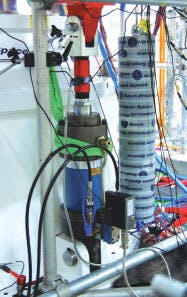Hydraulics ensure satellite structures test A-OK
Saab Ericsson Space, Linkping, Sweden, has launched more than 300 satellites into space. In one design, an ultra-light carbon fiber structure was used for a commercial communications satellite. What’s noteworthy about the application is that the carbon fiber composite is so strong that enormous forces are required to test its strength. But meaningful test results require slow and precise application of force, so designers specified hydraulics for testing it.
Pr Andersson, test engineer at Saab Ericsson Space, explains, “This was a unique project. Normally the motion sequences in our branch of industry are as fast as possible. In this case, however, it is exactly the opposite. The cylinders move very slowly but are absolutely controlled.”
The system is used for testing satellite separation systems. Saab Ericsson Space was awarded the contract from a European satellite manufacturer to develop a new ultra-light carbon-fiber structure for a large commercial communications satellite. The test equipment simulates loading to which the satellite is subjected during a launch. Accurate simulation of loading during takeoff is especially important because of the extremely strong vibrations during that portion of a launch.
Bosch Rexroth supplied all the hydraulic components — including 11 hydraulic cylinders — and the controls for this test system. Test axes simulate sheet metal and working loads, such as solar sails, antennae, and motors, which are mounted to a cylindrical structure serving as the satellite’s support framework. Axes are arranged in accordance with the equipment that will be attached to the structure for space missions.
Seven hydraulic cylinders arranged on top of the structure are used to simulate the vibrations transmitted during launch. To simulate the fuel tanks, four pairs of parallel-mounted cylinders are subsequently mounted inside the structure. Saab Ericsson Space specified CDM1 series cylinders from Bosch Rexroth. The cylinders for this application have bores ranging from 63 to 160 mm and operate with a maximum operating pressure of 160 bar.
Synchronized control
Each of these axes connected to the carbon fiber structure consists of a hydraulic cylinder and a proportional control valve. Force sensors with strain gauges are connected at each piston rod end. They measure the forces to which the satellite structure is subjected and provide electronic feedback to constantly regulate the required load forces from the cylinders.
Saab Ericsson Space demands that loads be tightly synchronized for this complex test device. The difference between actual and specified load on each axis must never exceed ±0.25%, which is where the control system comes in. In addition to the control panel with an industrial PC, the customer-specified system uses standard components, including Bosch Rexroth type VT-HNC 100 digital axis controls for all 11 cylinders. Each digital control has eight digital inputs/outputs and communicates via Probus DP.
Safe and reliable
Andersson is impressed with the design of the hydraulic system. “Even if the incredibly slow movement and absolute controlled cylinder travel demanded by us is an unusual application for hydraulics, everything functions smoothly,” he offered. During the load tests, the load is increased in small stages to 100% of the predetermined specifications.
The complex system required to collect these detailed data is demonstrated by the high number of sensors — 245 in all. Arranged on the carbon fiber structure, they record the deformation caused by the loading. For the first data analysis, the test is stopped at a loading of 40% of the preset total value. This first part of the test alone lasts 4 hr. In reality, the satellite structure must later withstand around 71% of the specified load. The remaining 29% is a safety factor for which satellites from Saab Ericsson Space are so well known.
This information was provided by Leif Mllergren, of Bosch Rexroth AB, Stockholm, Sweden. He can be reached at [email protected]. For more information, visit www.boschrexroth-us.com.



